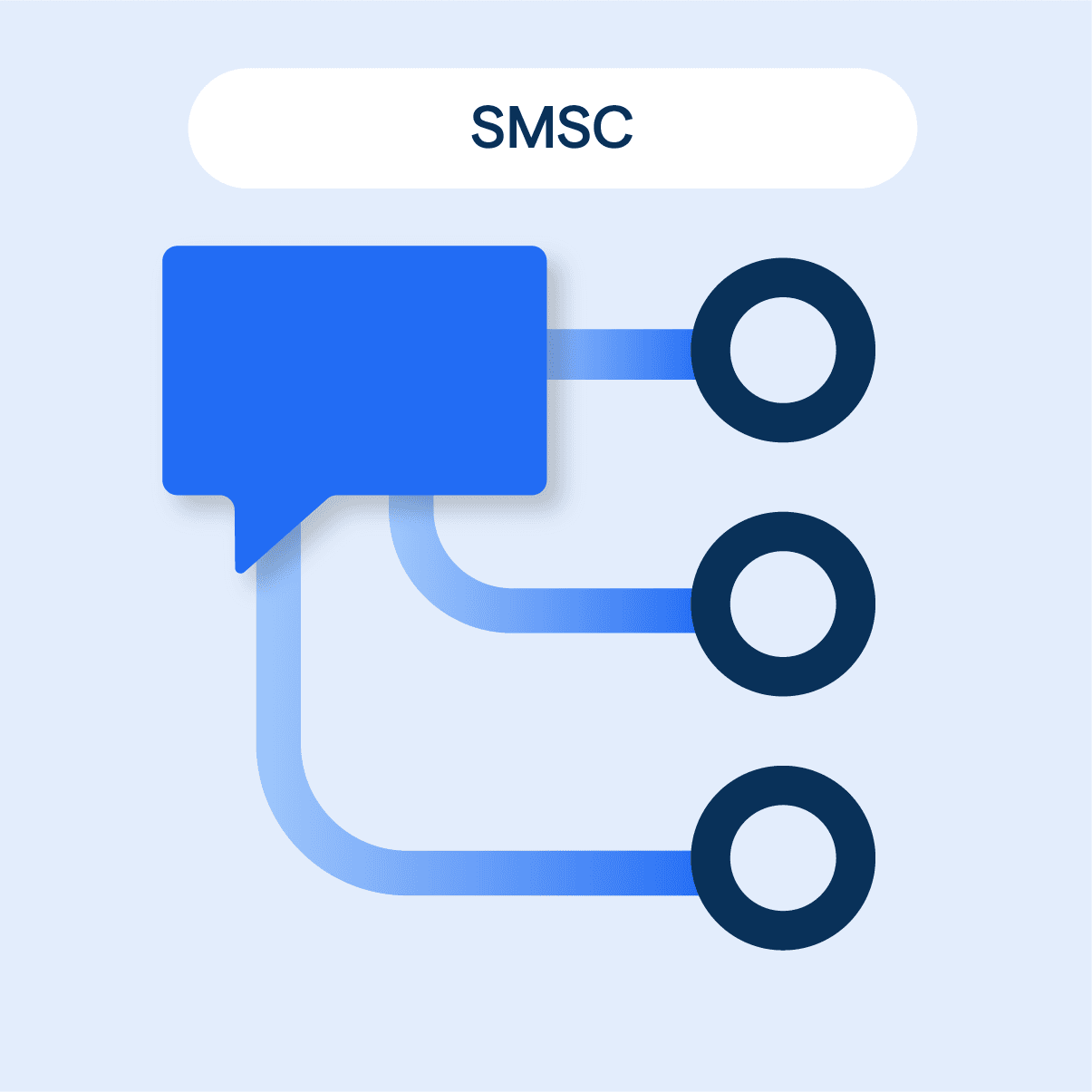What is SMSC?
SMSC is a software application that resides in the mobile network operator's infrastructure. It receives SMS messages from the sender's device and stores them until they are delivered to the receiver's device.
SMSC also ensures that the message is delivered to the correct recipient and provides delivery reports to the sender. There are two types of SMSC: home SMSC and visitor SMSC. Home SMSC is responsible for delivering messages to its subscribers, while visitor SMSC delivers messages to subscribers of other networks.
When a user sends an SMS, the message is first sent to the SMSC. The SMSC checks if the message is valid and then routes it to the appropriate destination. If the recipient is on the same network, the message is delivered to the home SMSC.
If the recipient is on a different network, the message is forwarded to the visitor SMSC. The SMSC then sends a delivery report to the sender, indicating whether the message was successfully delivered or not.
There are two types of SMSC: basic SMSC and enhanced SMSC. Basic SMSC is a simple messaging system that only provides basic message queuing and delivery functions. Enhanced SMSC, on the other hand, provides additional features such as message filtering, message storage, and message delivery confirmation.
SMSC vs SMS Gateway
SMSC and SMS gateway are often used interchangeably, but they are not the same thing. While SMSC is responsible for message routing and delivery, SMS gateway is a hardware or software application that connects mobile devices to other communication networks such as email, social media, or instant messaging.
Why is SMSC Important?
Reliable Messaging
SMSC (Short Message Service Center) ensures reliable delivery of SMS messages, playing a critical role in maintaining a stable and efficient messaging infrastructure.
Message Queuing
SMSC stores messages in a queue when recipients are unavailable, ensuring messages are delivered once the recipient's device is back online.
Message Routing
SMSC is responsible for routing SMS messages to the appropriate recipient, providing seamless communication between users on different networks.
Time Stamping
SMSC adds timestamps to messages, providing accurate information on when messages were sent and received, enhancing the user experience.
Delivery Reports
SMSC supports delivery reports, allowing users to track the status of their sent messages and confirm successful delivery, ensuring effective communication.
Network Interoperability
SMSC enables interoperability between different mobile networks, allowing users to send and receive SMS messages regardless of their network provider.
Who Uses SMSC?
SMSC is used by various entities in the mobile communication industry, including:
Mobile Network Operators
Mobile network operators use SMSC to deliver SMS messages to their subscribers. They also use SMSC to connect with other networks and deliver messages to subscribers of other networks.
SMS Aggregators
SMS aggregators are companies that provide SMS services to businesses and enterprises. They use SMSC to deliver SMS messages to their clients' customers.
Enterprises and Businesses
Enterprises and businesses use SMSC to send promotional messages to their customers. SMSC allows them to reach a large number of customers quickly and efficiently.
Consumers
Consumers use SMSC every time they send an SMS message. They may not be aware of the role of SMSC in SMS communication, but it plays a crucial role in ensuring that their messages are delivered to their intended recipients.
Applications of SMSC
Marketing and Promotions
Use SMSC to send promotional messages, special offers, and marketing campaigns to customers, reaching a wide audience and driving engagement.
Customer Support

Leverage SMSC to provide customer support through SMS, offering a convenient and accessible communication channel for resolving issues and answering queries.
Appointment Reminders
Utilize SMSC to send appointment reminders, confirmations, and rescheduling notifications, ensuring customers stay informed and reducing no-shows.
Two-Factor Authentication
Implement SMSC for two-factor authentication (2FA) by sending one-time passwords (OTPs) via SMS, enhancing security and protecting user accounts.
Emergency Alerts
Employ SMSC to deliver critical information and emergency alerts to users, ensuring timely communication during natural disasters, public safety incidents, or other urgent situations.
Internal Communication
Integrate SMSC into your organization's communication tools for efficient internal messaging, keeping employees informed and connected regardless of their location.
How to Use SMSC?
Select an SMS Provider
Choose an SMS provider that offers SMSC services, ensuring reliable message delivery and efficient communication across different networks.
Register and Configure
Sign up for an account with your chosen SMS provider and configure the necessary settings, such as API keys, sender ID, and authentication details.
Integrate with Your Application
Use the SMS provider's API or SDK to integrate SMSC functionality into your application, enabling SMS messaging capabilities for your users.
Compose and Send Messages
Create SMS messages within your application, ensuring they adhere to character limits and formatting guidelines, and use the SMSC service to send them to recipients.
Monitor Delivery Reports
Track the delivery status of your sent messages using the SMSC's delivery reports feature, ensuring that messages are successfully delivered and identifying any issues.
Manage Opt-in and Opt-out
Implement a system for users to opt-in or opt-out of receiving SMS messages, respecting their communication preferences and adhering to relevant regulations and best practices.
SMSC Features
SMSC provides several features that enhance SMS communication. These include:
Message Queuing
SMSC stores messages until they can be delivered to their intended recipients. This ensures that messages are not lost if the recipient's device is unavailable.
Message Routing
SMSC ensures that messages are delivered to the correct recipient, regardless of their network operator.
Message Delivery Confirmation
SMSC provides delivery reports to the sender, indicating whether the message was successfully delivered or not.
Message Filtering
SMSC can filter messages based on various criteria, such as keywords or sender ID.
Message Storage
SMSC can store messages for a specified period, allowing recipients to retrieve them later.
SMSC Security
SMSC is vulnerable to various security threats, including hacking and spamming. However, several security measures can be implemented to protect SMSC from these threats. These include:
SMSC Vulnerabilities
SMSC vulnerabilities include unauthorized access, denial of service attacks, and message interception.
SMSC Security Measures
SMSC security measures include access control, data encryption, and firewalls.
SMSC Encryption
SMSC encryption ensures that messages are transmitted securely between the sender and receiver.
SMSC Standards
Message Delivery Reliability
SMSC standards ensure the reliable delivery of SMS messages by implementing mechanisms like message queuing, retries, and delivery reports. This guarantees that messages are transmitted efficiently and accurately, even during high-traffic periods or network congestion.
Interoperability and Compatibility
SMSC standards promote interoperability and compatibility between different mobile networks, devices, and service providers. By adhering to these standards, SMSCs can seamlessly exchange messages across various platforms, ensuring a consistent user experience.
Security and Privacy
To protect user privacy and data integrity, SMSC standards include security measures such as encryption, authentication, and access control. These measures help prevent unauthorized access, eavesdropping, and tampering with SMS messages.
Scalability and Performance
SMSC standards support scalability and high-performance messaging by optimizing message routing, handling, and storage. This allows SMSCs to handle large volumes of messages efficiently, ensuring timely delivery and minimal delays.
Error Detection and Handling
To ensure accurate and reliable message transmission, SMSC standards incorporate error detection and handling mechanisms. These mechanisms identify and correct potential issues, such as malformed messages or network failures, and provide feedback to users when necessary.
Regulatory Compliance
SMSC standards ensure compliance with relevant regulations and industry guidelines, such as data protection laws and mobile network operator requirements. By adhering to these standards, SMSCs can maintain their reputation and avoid potential legal issues.
TL;DR
SMSC is a critical component of mobile communication that ensures the delivery of SMS messages between mobile devices. It provides several features that enhance SMS communication and is essential in mobile marketing. SMSC is vulnerable to security threats, but several security measures can be implemented to protect it. SMSC uses various protocols to communicate with other networks, and there are several SMSC providers in the market.
Frequently Asked Questions
What is a Short Message Service Center (SMSC)?
A Short Message Service Center (SMSC) is a network element responsible for handling and routing SMS messages between mobile devices and telecommunications networks.
How does an SMSC work?
An SMSC receives, stores, and forwards SMS messages, ensuring that they are delivered to the intended recipient or retried if delivery fails initially.
What is the role of SMSC in mobile networks?
SMSC plays a crucial role in mobile networks by enabling SMS communication between users, regardless of their location or network provider.
Can SMSC handle multimedia messages (MMS)?
While SMSC is designed for SMS, a similar component called Multimedia Messaging Service Center (MMSC) handles multimedia messages (MMS).
Are there alternatives to SMSC for messaging?
Alternatives to SMSC-based messaging include instant messaging apps like WhatsApp, Facebook Messenger, and iMessage, which use internet connectivity instead of SMS infrastructure.

